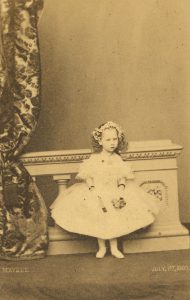[This series on royal cartes de visite began here.]

Queen Victoria and Prince Albert viewed Prussia as their ideal among the multitude of German kingdoms, principalities, and duchies. Early on in their marriage, they hoped that the son of their friends the Prince and Princess of Prussia – the former the heir presumptive to the kingdom – might someday marry their eldest daughter, Vicky, as Prince Frederick William duly did, in 1858, when the bride was just seventeen.
Fritz and Vicky were happy as a couple, but the friendly alliance of Great Britain and Prussia (from 1871 the nucleus of the German Empire) did not play out quite as the bride’s parents had expected. Instead of a liberal Germany presiding over the restless nations in eastern Europe, the British court watched in surprise as the comparatively progressive Prince of Prussia became the conservative Kaiser Wilhelm I and the once-obscure Prussian diplomat Otto von Bismarck became all-powerful at the courts of Wilhelm I (1871–88), Friedrich III (1888), and then Wilhelm II (1888–1918). Continue reading Royal cartes de visite: Part Three




